 Loading Image...
Loading Image... Loading Image...
Loading Image...|
Grandfather Style’© Steve Masley (Click IMAGE to Enlarge) Buy a Print of this Photo  |
Pesticide residues. Outbreaks of e. coli and salmonella, even on organic produce. A lot of people want to know how to grow vegetables organically, in their own back yard.
Most backyard gardeners would rather not deal with toxic chemicals, if they have an alternative. Fortunately, they do.
Pests key in on weak plants. Organic gardening relies on healthy, vigorous plants as the first defense against pests and diseases.
Plants don’t just sit there, letting bugs and diseases attack. They can’t feel it when a bug is chewing on a leaf, but they can detect metabolites of their own leaves in the saliva of chewing insects.
|
© Steve Masley Click IMAGE to Enlarge |
Once they do, they start pumping out chemicals to inhibit feeding. Some of the chemicals plants create for self-defense are important phytochemicals in the human diet. Healthy plants mount vigorous defenses against pests and diseases.
Conventionally grown vegetables are couch potatoes by comparison. Their roots are bathed in chemical fertilizers, and their leaves are sprayed to kill anything that crawls. They produce few of these valuable phytochemicals.
So the issue is, how to grow vegetables that are robust enough to repel pests, without chemical fertilizers?
Organic gardeners “feed the soil to feed the plants”, adding compost, animal manures, and/or organic soil amendments to increase soil organic matter and amplify the soil food web.
Extreme heat, cold, wind, or drought can stress even robust plants, weakening their defenses and allowing pests to attack them. When this happens, organic gardeners rely on natural garden pest control to check garden pests.
If you want to learn how to grow vegetables organically, you can start with some general information on the difference between summer vegetables and fall vegetables—basically the difference between fruit and vegetables—and why it’s important.
For information on how to grow vegetables in containers, click Here.
Alliums (Onions)
|
Amaranths (Spinach)
|
Brassicas (Broccoli, Cabbage)
|
Cucurbits (Cucumbers, Squash, Melons)
Legumes (Beans, Peas)
|
Nightshades (Tomatoes, Peppers, Eggplants)
Umbellifers (Carrots, Celery)
|
Miscellaneous (Miscellaneous Vegetables)
|
Masley…Click IMAGE to Enlarge |
Each vegetable page is plant profile,
with information on:
If you want to learn how to grow vegetables, it helps to know something about vegetable plant families. Most vegetables fall into one of 7 plant families (links below), but a few—like corn and rhubarb—have no close crop cousins, so they’re grouped under “miscellaneous”.
Plants in the same family have similar soil, fertility, and cultural needs, and share many common pests and diseases. If you know how to grow tomatoes, you also know something about growing peppers, eggplants, and potatoes.
Knowing about crop families also helps with pest control and crop rotation. Growing vegetables from the same family on the same spot year after year depletes soils of the nutrients needed by that crop, and allows pests and diseases to multiply.
Below you’ll find photo galleries for each crop family, with links to instructions for growing them above each gallery.
The photos of vegetables below come from my garden and balcony farm, although a few choice pictures come from other gardens at the Stanford Community Farm, where I have a plot. Click any photo to see a larger image and description.
All Photos © Steve Masley.
Alliums: Chives | Garlic | Leeks | Onions
Scallions | Shallots

|
Alliums are onion family plants that are sown in early spring in cold-winter gardens. In areas where the ground doesn’t stay frozen through winter, they’re sown in fall and allowed to overwinter.
In onions, day length initiates bulb formation in most varieties. At low latitudes—below 35°—summer days aren’t long enough to initiate bulb formation in medium- and- long-day varieties, so southern gardeners should choose short-day varieties. Day length is less important for shallots, garlic, leeks, and scallions.
Alliums are moderate feeders that perform best in soils with lots of organic matter, and a neutral to slightly alkaline pH—7-7.5. See Changing Soil pH for ways to adjust pH.
Alliums need regular water during their most pronounced growth, but once the tops have sized up and start flopping over, they should be allowed to “dry back” for a week or so before harvesting. This improves storage life by allowing protective skins to form on the bulbs.

|

|

|

|
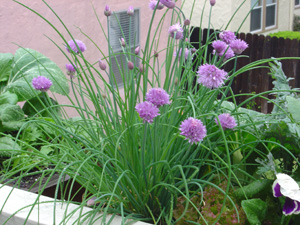
|
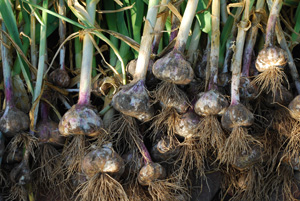
|
Amaranths (Chenopodioids): Beets | Spinach | Swiss Chard
Amaranths grow best in the cooler temperatures of spring and fall. Most bolt—send up a flower stalk—quickly in high summer temperatures, although they can be grown in cooler microclimates, like partial shade from other vegetables.
Amaranths need regular, steady water, and perform best in slightly alkaline soils with lots of organic matter and supplemental calcium. Beets are light feeders, but spinach and Swiss Chard benefit from extra compost, composted manure, and high-calcium organic soil amendments like dried, ground eggshells or ground oyster shells.
 |
 |
 |
Up to Vegetable Plant Families NavBar
Brassicas (Crucifers): Asian Greens | Broccoli | Brussels Sprouts
Cabbage | Cauliflower | Collards | Kale | Radishes | Turnips

|
Brassicas, or Cruciferous Vegetables are cool-season vegetables that bolt in high summer heat, but thrive in the cooler temperatures of spring and fall.
Continuous, steady growth is the key to growing brassicas and other cool-season vegetables. Anything that disrupts this steady growth—like a hot, dry spell—signals the plant it’s time to stop making leaves, and shift to producing stalks, flowers, and seeds.
All brassicas need continuous, steady water, especially during dry spells and unseasonal heat. Brassicas perform best in neutral to slightly alkaline soils with lots of organic matter and good drainage.
Incorporate a thick layer of good garden compost or composted manure into the soil at planting time. Use less for root-forming brassicas like radishes and turnips, which are moderate feeders. Use more for all other brassicas, which are heavy feeders.
If your soil is lean, brassicas benefit from supplemental organic soil amendments.

|

|

|

|

|

|
Up to Vegetable Plant Families NavBar
Cucurbits: Cucumbers | Melons | Pumpkins
Summer Squash | Winter Squash | Zucchini

|
Cucurbits—cucumbers, melons, and squash—are sub-tropical natives grown as summer vegetables in temperate climates. Their leaves turn to green goo at the first touch of frost, so don’t waste time planting them too early.
Cucurbits are heavy feeders that perform best in a slightly acidic soil—pH 6.5-7—with ample organic matter. For information on lowering soil pH, click Here.
Mix a thick layer of good garden compost or composted manure into the soil at planting time. Organic soil amendments can be built into the soil when planting vegetables, for a sustained, summer-long release of nutrients.
Cucurbits, like other fruiting plants, benefit from supplemental organic phosphate sources like colloidal phosphate.
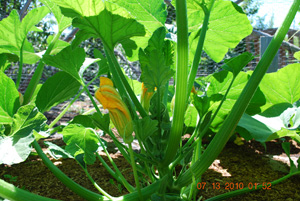
|

|

|

|

|

|
Up to Vegetable Plant Families NavBar
Legumes: Beans (Shelling) | Green Beans | Peas
|
© Steve Masley Click IMAGE to Enlarge |
Legumes have both cool-season and summer vegetables in the same plant family. Peas and fava beans are cool-season plants that grow best in spring and fall, but cook out in hot weather. Green beans are summer vegetables that languish and die when the weather is consistently cold.
Legumes grow well in soils with ample organic matter and good drainage, but little or no fertilizer, since they’re able to fix their own nitrogen fertilizer from the atmosphere thanks to symbiotic Rhizobia colonies on their roots.
In vegetable crop rotations, legumes are planted after heavy feeders to restore fertility to the soil.
Peas and fava beans like a neutral to slightly alkaline soil (pH 7-7.5), while green beans do better in a slightly acidic (pH 6.5-7) soil. See Changing Soil pH for information on adjusting soil pH.

|

|

|
Up to Vegetable Plant Families NavBar
Nightshades (Solanacea): Eggplants | Hot Peppers (Chiles)
Sweet Peppers | Potatoes | Tomatoes
|
Masley…Click IMAGE to Enlarge |
Nightshades include some of our favorite summer vegetables—tomatoes, peppers, chiles, eggplants, and potatoes. Like Cucurbits, they’re subtropical natives grown as annuals in temperate zones.
They have little to no cold tolerance, and die at the first touch of frost. With the exception of potatoes, they’re grown for their fruit, instead of their leaves or stalks.
Nightshades are heavy feeders that like a loose, loamy soil with ample organic matter and good drainage. Mix a thick layer of good garden compost or composted manure into the soil at planting time. Organic soil amendments can be built into the soil at planting time for a sustained, summer-long release of nutrients.
Nightshades benefit from supplemental organic phosphate sources like colloidal phosphate.

|

|
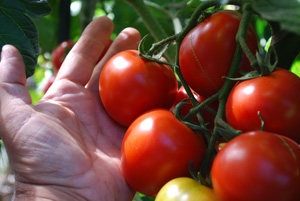
|

|

|

|
Up to Vegetable Plant Families NavBar
Umbellifers: Carrots | Celery | Cilantro
Dill | Fennel | Parsley | Parsnips

|
Umbellifers are mostly cool-season vegetables, although many varieties are adapted to grow and even thrive in summer heat. They include tap-rooted vegetables like carrots and parsnips, crops grown for their stalks, like celery and fennel, and leaf vegetables/herbs, like parsley, cilantro, and dill.
Umbellifers need loose, good-draining soil, but their nutritional needs vary. Celery and fennel are heavy feeders that do well with the same soil regime as brassicas: lots of good garden compost or composted manure worked into the soil prior to planting, or the addition of other organic soil amendments.
Parsley, cilantro, and dill perform well in almost any garden soil, as long as it drains well. Carrots and parsnips are light feeders. Excess soil nitrogen produces huge green tops and skinny roots prone to forking, so avoid planting them in the same bed as heavy feeders.
Umbellifers are also among the best plants for attracting beneficial insects to your garden, and sustaining them once they arrive. Their lacy foliage creates still pockets of air and good hunting for insect predators, and their abundant, tiny flowers attract parasitic wasps.

|

|

|

|

|

|
Miscellaneous Vegetables: Artichokes | Lettuce
Rhubarb | Sweet Corn

|
Some common garden vegetables—like artichokes—have no close edible cousins in the same plant family, so I’ve included a “miscellaneous” photo gallery for these outrider vegetables.
The needs of these vegetables fit no common pattern. For information on how to grow vegetables in this group, click on individual plant links.

|

|
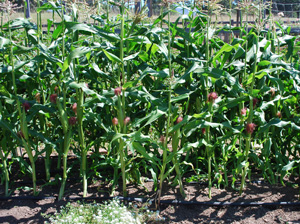
|
Artichokes
|
Basil
|
Beans
|
Broccoli
|
Cabbage
|
Carrots
Cucumbers
|
Green Beans
|
Hot Peppers
|
Lettuce
|
Peppers
Spinach
|
Summer Squash
|
Tomatoes
|
Winter Squash
|
Zucchini
|
To Follow Grow-it-Organically.com:
|
Copyright © 2009-2025, by Steve Masley, Grow-it-Organically.com
All rights reserved
HOME | About Us | Contact Us | Privacy
New! Comments
Have a question or comment about what you just read? Leave me a comment in the box below.